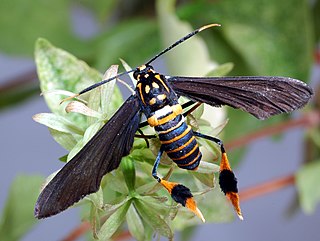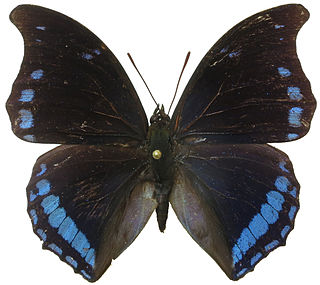Sir George Francis Hampson, 10th Baronet was a British entomologist.

Nepticulidae is a family of very small moths with a worldwide distribution. They are characterised by eyecaps over the eyes. These pigmy moths or midget moths, as they are commonly known, include the smallest of all living moths, with a wingspan that can be as little as 3 mm in the case of the European pigmy sorrel moth, but more usually 3.5–10 mm. The wings of adult moths are narrow and lanceolate, sometimes with metallic markings, and with the venation very simplified compared to most other moths.

Eupterotidae is a family of insects in the order Lepidoptera with more than 300 described species.
Urodidae or "false burnet moths" is a family of insects in the lepidopteran order, representing its own superfamily, Urodoidea, with three genera, one of which, Wockia, occurs in Europe.
Copromorphoidea, the "fruitworm moths" is a superfamily of insects in the lepidopteran order. These moths are small to medium-sized and are broad-winged bearing some resemblance to the superfamilies Tortricoidea and Immoidea. The antennae are often "pectinate" especially in males, and many species of these well camouflaged moths bear raised tufts of scales on the wings and a specialised fringe of scales at the base of the hindwing sometimes in females only; there are a number of other structural characteristics. The position of this superfamily is not certain, but it has been placed in the natural group of "Apoditrysia" "Obtectomera", rather than with the superfamilies Alucitoidea or Epermenioidea within which it has sometimes previously been placed, on the grounds that shared larval and pupal characteristics of these groups have probably evolved independently. It has been suggested that the division into two families should be abandoned.
Agathiphaga is a genus of moths in the family Agathiphagidae, known as kauri moths. This caddis fly-like lineage of primitive moths was first reported by Lionel Jack Dumbleton in 1952, as a new genus of Micropterigidae.

Polyommatus eros, the Eros blue or common meadow blue, is a species of blue butterfly found in Europe.

Horama is a genus of tiger moths in the family Erebidae.

The Thyatirinae are a subfamily of the moth family Drepanidae with about 200 species described. Until recently, most classifications treated this group as a separate family called Thyatiridae.
Poliopastea is a genus of tiger moths in the family Erebidae.
Victor Gurney Logan Van Someren was a zoologist and entomologist.

Charaxes lycurgus, the Laodice untailed charaxes, is a butterfly in the family Nymphalidae. It is found in Guinea, Sierra Leone, Liberia, Ivory Coast, Ghana, Togo, Nigeria, Cameroon, Equatorial Guinea, Gabon, the Republic of the Congo, the Central African Republic, Angola, the Democratic Republic of the Congo, Sudan, Uganda and Tanzania. The habitat consists of lowland evergreen forests and riverine forests.
Poliopastea nigritarsia is a moth of the family Erebidae. It was described by George Hampson in 1898. It is found in Mexico, Guatemala and Trinidad.
Poliopastea clavipes is a moth in the subfamily Arctiinae. It was described by Boisduvalin 1870. It is found from Texas, Mexico, Guatemala and Costa Rica to Venezuela.

Poliopastea auripes is a moth of the subfamily Arctiinae. It was described by Francis Walker in 1854. It is found in Honduras, Guatemala, Panama, Costa Rica and Colombia.
Poliopastea coelebs is a moth in the subfamily Arctiinae. It was described by Felix Bryk in 1953. It is found in the Amazon region.
Poliopastea lamprosoma is a moth in the subfamily Arctiinae. It was described by George Hampson in 1914. It is found in Panama.
Poliopastea maroniensis is a moth in the subfamily Arctiinae. It was described by Schaus in 1905. It is found in French Guiana.









